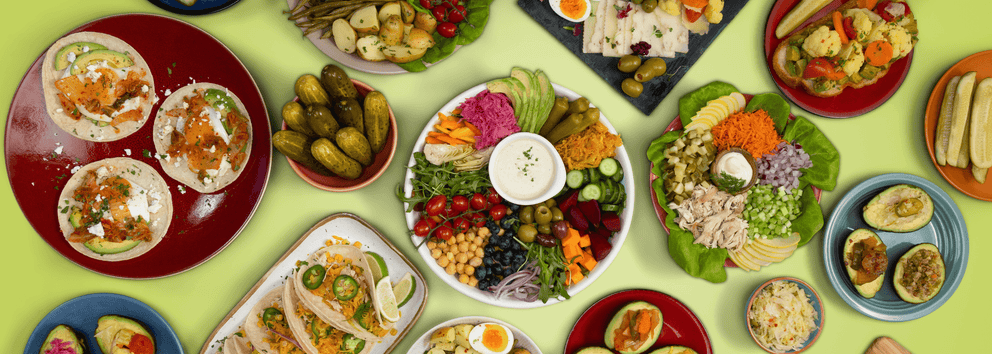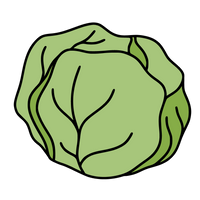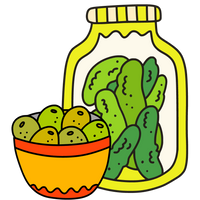
Are you a fermented food lover who is here for the complex and rich flavors of fermented foods or for the pop of probiotics and live cultures that keep your gut happy and healthy?
The good news is that with our ferments, you don't have to choose.
Our products bring the best of both worlds together in one delicious package. Moreover, we have tons of ideas to ensure you never get bored with your fermented food choices.
In this blog, we're sharing healthy and creative ways to include fermented foods in your breakfast, lunch, dinner, and even snacks. So, whether you are a hardcore fermented food lover or a newbie to the scene, get excited for some creative ideas to boost your fermented food game!

Benefits of Fermented Foods for Gut Health
The health benefits of fermented foods are many, starting with their lactic acid bacteria. The fermentation process creates naturally occurring 'good guy' bacteria known as probiotics. By now we know from recent science, that these probiotics confer a health benefit to the resident gut microbiome.
Here at Olive My Pickle, we often get the question - How much fermented food should I eat?
We advocate eating fermented foods three times per day, as snacks or with meals.
It's the consistent introduction of these live culture fermented foods to your microbiome that creates the most gut health benefits.
And what's more, eating a variety of different fermented foods is key. That's because each one has a distinct probiotic profile, and it's by this diversity of microbial exposure that your microbiome thrives.
Three times a day as a lifestyle approach means a lot of fermented foods over the course of your long, healthy life! It's important to stay creative, so you don't get bored.
Novelty and adventure in your good health habits will mean they stick. This guide will get you started eating fermented foods with every meal.
Setting the Intention: Why Do You Want to Eat More Fermented Food?
Prior to getting started with a new healthy habit, it's important to define your intentions and your plan. This will help create new good habits by putting the pieces in place to make life easy.
Have you heard about the health benefits of fermented foods? Are you seeking to improve gut health and digestion? Define your why and remember it.
Wrapping positive emotion around your why and declare your intent by saying out loud, "I love and support my body and it deserves only the best and I deserve to feel good. I'm committed to my health and I am powerful to change," is an example of defining and declaring your why. You'll stay on course with your healthy habits (in all areas of your life) if you talk kindly to yourself this way.
Plan Your Healthy Servings of Fermented Food
We have a four simple principles for incorporating fermented foods into your daily life. You might call these the secrets to success:
#1 Frequency
A common question we receive is 'how much fermented should I be eating?' For those that are used to fermented or probiotic foods and consume a good amount of fiber, the right amount is three times a day.
The amount you consume doesn't have to be a lot.
Serving sizes are quite reasonable, for example, a half a pickle, or a quarter cup of sauerkraut. It's the consistent introduction of fermented foods to your gut biome—that's the key.
If you are brand new to fermented foods and just beginning to increase your fiber intake OR if you have any known gut issues, you should start more conservatively. Try half a serving size, then see how you feel. Build up from there as your body grows used to the introduction of probiotic and foods.

#2 Variety
Important to have enough fermented foods to choose from, but not be overwhelmed by choice. At Olive My Pickle, we have 40+ varieties, which is a lot!
We deliberately created a product line with an abundance of variety because we know long-term habits are sustained with novelty and diversity.
Plus, your microbiome prefers it that way-- a mix of microbial diversity (consistently introduced) is the optimal way to eat fermented foods for a healthy gut.
The key is eating an abundance of different types of probiotic bacteria, consistently introduced to the resident microbiome. The probiotics you eat are ‘visitors' in your gut. They are welcome guests that travel through your digestive tract.
Think about when you have welcomed guests in your home. You clean the house, you create a great environment for them, and you listen to what they have to say to you. These visiting live bacteria offer the same feedback to the resident microbiome: they instruct, interact and drill it, so it can stay sharp. The more variety of probiotic bacteria you eat, the better these interactions are. (1)

#3 Access
You can't eat what you don't have in your fridge.
Stock up so that when inspiration strikes you'll have plenty of fermented foods on hand to enjoy.
When you shop, choose about 80% of products that you know you'll love and eat.
An example would be popular Kosher Dill Pickles or Butter Olives. Kraut favorites would be easy options like Carrot + Dill Kraut or the ever-popular Classic Kimchi
Get about 20% 'other'-- items you're not sure you'll love, but that have grabbed your interest! Experiment, try new things, be curious and see all this as an adventure. You may just discover your new favorite ferment.
While we're on the subject of access, it's worth it to point out again that you can't eat what you don't have stocked. That also applies to junk food or inflammatory foods that counteract your healthy habits. To keep these foods from coming into the household, don't buy them.
PRO TIP
To resist the temptation to buy them, go to the grocery store on a full stomach, preferably after eating a meal high in good fats, because fat send messages of satiety to the brain. Grocery shopping after eating a plate of two butter fried eggs with a side of avocado and some kraut will help you resist buying the junk you don't want. Try it and see.
Also, although this article focuses on creative ways to add ferments to your gut-healthy diet, we recommend achieving this with a variety of probiotic-rich foods and drinks. Some of our favorites include raw, fermented dairy like kefir and yogurt, apple cider vinegar, and drinks such as sugar kombucha, kefir water and kvass. There’s also an abundance of dressings, sauces and salsas with live cultures that are now more widely available in stores.
#4 Visibility
Designate a space in your fridge for your ferments, preferably in the door.
Our products were designed to fit there perfectly. If you have kids, keep their favorites at eye level so they can reach for a healthy snack. The visibility will be a constant reminder to you that they're there. And when you see them, you're more likely to remember to eat them.
How to Incorporate Fermented Foods at Every Meal
If you're new to eating ferments and wondering how to even begin to add them into your diet 3 times a day, we have plenty of recipes and snack ideas to get you started! Once you get into a routine, you'll be surprised at how effortless (and enjoyable) it is to eat fermented foods with every meal!
Breakfast: Starting Your Day Right With Fermented Foods
The tangy, strong, sour flavors of fermented vegetables can take some getting used to in the morning, but there is no better way to begin your day because of the gut health benefits. Here's 4 ideas to get you started, but we have plenty more where that came from on our blog, 8 Easy Gut-Healthy Breakfast Ideas to Energize Your Day.

#1 Spicy Breakfast Ideas
Substitute hot sauce with OMP's Heat + Spicy Sauerkraut or , next to or on top of eggs. If the heat is too much, all of our krauts and kimchis are nice, salty complement to any egg dish.

#2 Breakfast Tacos
Add a soft corn or almond flour tortilla and some avocado to make a simple huevos ranchero ‘el fermente' style. Remember to reduce salt seasoning when adding fermented vegetables into your breakfast mix.

#3 Probiotic Smoothie
More of a smoothie-in-the-morning type? Try our one of 12 LiveBrine Smoothie recipes for a natural way to get those beneficial probiotics in early.

#4 Shot of Pickle Juice First Thing
We call it the Rise & Brine. Take a shot of LiveBrine Probiotic Pickle Juice upon waking. Chase it with your lemon water. Then move on to your power coffee (complete with MCT Oil and grass-fed butter.)
Lunch: Energize Your Afternoon With Ferments
Simply garnishing your plate with a pickle is certainly an easy way to achieve a probiotic-rich midday meal, but getting more creative helps sustain good lifelong habits.
Here are a few ways to get your ferments in at lunch hour:

Chopped Pickles in Your Salads
Chop up pickles to fortify your egg, potato, chicken, or sardine salad with a flavor-packed, probiotic-rich infusion. (Replace tuna with sardines. Tuna can be high in mercury. Sardines are equally delicious, far more nutritious--packed with B12 and Omega 3 fats - not mention, sardines are more economical.)

Healthy Condiments
Any vegetarian, cheese or nitrate-free lunch-meat sandwich tastes better with fermented sauerkraut or sliced pickles as a condiment.

Probiotic Salad
For salads, use probiotic brine in your homemade dressing (2 parts liquid brine, 1 part extra virgin olive oil) to make a great tasting, superfood salad dressing). Probiotic LiveBrine can be used to flavor anything—not only does it replace the need for table salt, but it also contributes a delicious and strong fermented flavor component to your dish without adding calories.
For many more dressing and sauce recipes made with LiveBrine pickle juice, check out 19 Recipes Made with Dill Pickle Juice.

Probiotic Marinade or Salt-Add
Brush grilled vegetables lightly with butter and salty probiotic brine to change their flavor dynamic and boost your good bacteria intake.
Dinner: The Versatile Garnish to any Meal
Many cultures across the globe that add naturally fermented foods to each meal as a lifestyle also eat lighter dinner fare than we do here in the West.
Once or twice a week, change up your ‘chicken and rice' hot dinner menu with a Mediterranean-inspired meal. Place the food in the middle of the table and enjoy family-style. The abundance of healthy fat will satisfy your appetite and the fermented foods with their strong flavors will satisfy your taste buds. Adapting to this low-maintenance, healthy dinner style is easy, quick, and appeals to both kids and adults.

Healthy Items for Your Mediterranean Diet Meal Spread
- Medium-boil eggs
- Raw, high-quality cheese for protein and fat
- Toast healthy, gluten-free bread or crackers and season olive oil with sea salt for dipping
- Salmon lox
- Smoked oysters
- Simple raw vegetables like tomato slices, avocado chunks, and slivered onions, drizzled with olive oil are simple and delicious
- Small bowls of fermented vegetables, pickles and sauerkraut
- Hummus garnished with chickpeas, paprika, and olive oil
- Sourdough bread

Creative Ways to Snack on Fermented Foods
Sometimes you just want to open the fridge and munch.
Go for something fermented as your first option. The flavors are intense so they satisfy your taste buds. Got late night salt cravings?

Skip the chips and eat a pickle to get that salty flavor.
It'll take care of the craving and net you exactly zero calories. (It's also difficult to overeat fermented vegetables versus salty, crunchy, processed foods like chips and microwave popcorn).

Crave sugar at night?
There is an abundance of anecdotal evidence that suggests ferments are effective at reducing sugar cravings. Although this is an area where more scientific research is needed, many nutritionists and functional doctors recognize the correlation between fermented foods and reduced sugar cravings, which helps with weight loss. Because we know that one role the microbiome plays is in appetite control and body weight moderation, it makes sense that feeding it optimal foods will help it moderate cravings. (2)

End your day like you started
Take a swig of probiotic pickle brine after your workout or after spending time outside on a hot summer day. The brine will replace electrolytes in your system, speeding your body's recovery.
Many of our customers that suffered from night cramping tell us they have solved this by taking a shot of pickle juice before bed. It's also an extra probiotic boost for your gut. Gulping down probiotic brine is another easy and fast way to get an abundance of good bacteria delivered to your microbiome for digestive health with no planning and no time spent.
Time to Make Fermented Foods Part of Your Lifestyle
There are so many creative ways to eat your three servings a day of fermented foods. This article has shown you the basics and how to get started. Remember, this is all about sustaining healthy habits, creating a system to support those habits, and remembering why you started. And the most important thing: remember to have fun along the way.
Build gut-healthy habits and add variety to your diet with Olive My Pickle’s probiotic-rich fermented foods. With over 40 delicious options to choose from, you're guaranteed never to get bored. Build Your Box and get creative in the kitchen!
References
DISCLAIMER: THIS WEBSITE DOES NOT PROVIDE MEDICAL ADVICE
The content on this website is for informational or educational purposes only and does not substitute professional medical advice or consultations with healthcare professionals. Always seek the advice of your physician or other qualified healthcare provider(s) with any questions you have regarding a medical condition or treatment and before undertaking a new health care regimen.










